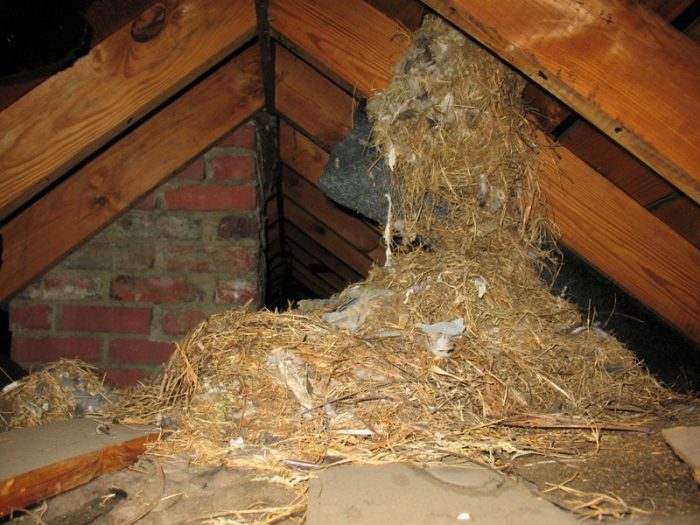Attic Access
- 22 ½" X 30" is considered the standard minimum safe access opening size;
- Describe access location(s) in the report;
- Any access restrictions? (closet shelves, lighting, owner's belongings)
- Is the hatch lid insulated? Condition of pull-down ladder (look for cut framing)
- If you are unable to enter the attic, state this in your report.
- Adequate headroom is a decision made by the inspector.
Airborne Particulates
Airborne particulates are a hazard to those who must enter attics (and crawlspaces). Types of particulates that may be found in attics include:
- Thermal insulation: When it’s walked through, most insulation, including fiberglass, releases particulates into the air that are small enough to be inhaled. Although fiberglass is not known to be a carcinogen, it is an irritant, and other types of insulation may contain chemicals that are carcinogenic or may contain asbestos.
- Raccoon Roundworm Encephalitis: is a pathogen that can lie dormant in raccoon feces for years. When dry feces are crushed by foot traffic it can release eggs that, once inhaled, can cause serious or fatal disease in humans.
- Hantavirus: is spread by rodents. Once the virus becomes airborne it can be inhaled, or it can enter the human body when someone touches infected material and then touches their eyes, nose, or mouth. Hantavirus can be a serious disease.
- Bird droppings may carry up to 50 different types of disease, many of which can be spread through contact with airborne particles.
Other Hazards
- Bats can carry rabies. Rabies, once it has developed is almost always fatal.
- Tetanus: tetanus is cause by a bacterium that typically enters the human body through puncture wounds. Attics are full of nail points, just look up while you’re in any attic.
- Stinging insects: if you suddenly find that you have disturbed a nest of stinging insects you have two avenues of escape:
- Hurry to the attic access hatch, or
- Kick your way through the ceiling drywall and drop to the floor below (not the preferred method).
#1 is better than #2, but a better solution is to wear PPE so that you're not constantly being stung as you leave the attic!
The safest PPE is a long-sleeve jump suit, a painter’s hood, full-face respirator, and gloves. Each step an inspector takes to utilize this equipment reduces the chance that he will contract a disease.

